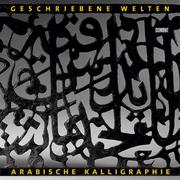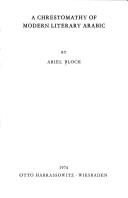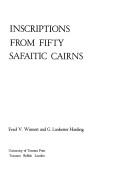| Listing 1 - 10 of 57 | << page >> |
Sort by
|

ISBN: 3832175075 Year: 2004 Publisher: Frankfurt Museum für angewandte Kunst
Abstract | Keywords | Export | Availability | Bookmark
 Loading...
Loading...Choose an application
- Reference Manager
- EndNote
- RefWorks (Direct export to RefWorks)
Book
ISSN: 03088421 ISBN: 9781905739349 1905739346 Year: 2010 Volume: 40 Publisher: Oxford: Archaeopress,
Abstract | Keywords | Export | Availability | Bookmark
 Loading...
Loading...Choose an application
- Reference Manager
- EndNote
- RefWorks (Direct export to RefWorks)
Arabic language --- Arabic alphabet --- Writing, Arabic --- Paleography, Arabic --- Written Arabic --- History --- Paleography, Arabic. --- History. --- Conferences - Meetings --- Arabic paleography --- Alphabet --- Semitic languages --- Written Arabic&delete& --- Arabic language - Written Arabic - History --- Arabic alphabet - History --- Writing, Arabic - History

ISSN: 05547342 ISBN: 3447015551 9783447015554 Year: 1974 Volume: 14 Publisher: Wiesbaden: Harrassowitz,
Abstract | Keywords | Export | Availability | Bookmark
 Loading...
Loading...Choose an application
- Reference Manager
- EndNote
- RefWorks (Direct export to RefWorks)
Arabic language --- Short stories, Arabic --- Readers --- Short stories, Arabic. --- Readers. --- Arabic short stories --- Arabic fiction --- Arabic language - Readers
Book
ISBN: 9782724704440 Year: 2007 Publisher: Le Caire Institut français d'archeologie orientale
Abstract | Keywords | Export | Availability | Bookmark
 Loading...
Loading...Choose an application
- Reference Manager
- EndNote
- RefWorks (Direct export to RefWorks)
Arabic language --- Birds --- Fishes --- Proverbs, Arabic
Book
ISBN: 3795906741 Year: 1994 Publisher: Wilhelsmhaven Florian Noetzel Verlag
Abstract | Keywords | Export | Availability | Bookmark
 Loading...
Loading...Choose an application
- Reference Manager
- EndNote
- RefWorks (Direct export to RefWorks)
Arabic language --- Folk music --- English --- Arabic
Book
ISSN: 00793426 ISBN: 8304006480 8304022923 9788304006485 9788304022928 Year: 1986 Volume: 13, 15, 17, 19 Publisher: Kraków Polskiej Akademii Nauk - Oddzial w Krakowie
Abstract | Keywords | Export | Availability | Bookmark
 Loading...
Loading...Choose an application
- Reference Manager
- EndNote
- RefWorks (Direct export to RefWorks)
Turkish language --- Foreign elements --- Arabic

ISBN: 0802022820 9780802022820 Year: 1978 Volume: 9 Publisher: Toronto: University of Toronto press,
Abstract | Keywords | Export | Availability | Bookmark
 Loading...
Loading...Choose an application
- Reference Manager
- EndNote
- RefWorks (Direct export to RefWorks)
Inscriptions, Safaitic --- Safaitic inscriptions --- Inscriptions, Arabic
Book
ISSN: 03924866 ISBN: 9788862277020 9788862277037 8862277024 8862277032 Year: 2014 Volume: 87/1 Publisher: Pisa: Fabrizio Serra,
Abstract | Keywords | Export | Availability | Bookmark
 Loading...
Loading...Choose an application
- Reference Manager
- EndNote
- RefWorks (Direct export to RefWorks)
Book
ISBN: 3110247046 9786612912054 3110247054 1282912054 9783110247046 9783110247053 9781282912052 Year: 2010 Publisher: New York, NY ; Berlin : De Gruyter,
Abstract | Keywords | Export | Availability | Bookmark
 Loading...
Loading...Choose an application
- Reference Manager
- EndNote
- RefWorks (Direct export to RefWorks)
Arabic letters on papyrus challenge the modern reader. There are few to no diacritical dots to distinguish homographs, no systematic spacing between single words, and in the majority of cases a low degree of graphical structuring. However, contemporary readers usually read and understood these documents easily - probably because the recipient of a letter knew what to expect. The letters are formulaic, and their information packaging follows an algorithm typical for their time and content. Here formulaic letter writing means not only the reuse of the same formulae or topoi but expressing though
Arabic letters --- Letter writing, Arabic --- Manuscripts, Arabic (Papyri) --- History and criticism. --- History. --- Arabic papyri --- Arabic letter writing --- Manuscripts, Arabic (Papyri). --- Lettres (Genre littéraire) arabes --- Papyrus arabes --- Manuscripts (Papyri) --- Arabic literature --- History and criticism --- History --- Letter writing --- Correspondance --- Histoire et critique --- Histoire --- Arabic letters. --- Arabisation. --- Epistolography. --- Islamisation. --- Correspondance arabe --- Égypte --- Sources --- Antiquité --- Moyen-âge --- Égypte --- Antiquité --- Moyen-âge
Book

ISBN: 9780861591602 0861591607 Year: 2011 Volume: 160 Publisher: London British Museum
Abstract | Keywords | Export | Availability | Bookmark
 Loading...
Loading...Choose an application
- Reference Manager
- EndNote
- RefWorks (Direct export to RefWorks)
This catalogue is the first on the outstanding collection of Arabic and Persian seals and amulets in the British Museum, by a specialist in the field. The first part focuses on the 638 Arabic, Persian and Indian seals covering material from the 8th to the 20th century. The introduction covers seal practice in different periods and levels of society; the role of the seal and the "alama" or motto, the use of figural representation on the seals, seal engravers, the forgery of seals and the importance of the stones used are described. The features of the seals themselves, in particular the palaeography and dating of early Islamic seals, some grammatical features of the inscriptions, and the range of designs present on the seals are analysed. The types and form of Islamic names, the range of phrases that commonly appear and the characteristics of later seals are also discussed. The second part focuses on 170 amulets in the collection preceded by an introduction to the subject. Research into the engraving techniques is presented with analysis of the stones used. This publication will be a standard work of reference for years to come.
Seals (Numismatics) --- Amulets --- Inscriptions, Persian --- Inscriptions, Arabic --- British Museum
| Listing 1 - 10 of 57 | << page >> |
Sort by
|

 Search
Search Feedback
Feedback About UniCat
About UniCat  Help
Help News
News